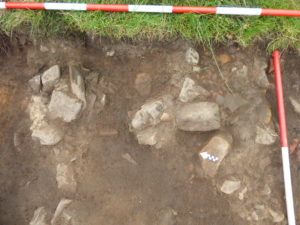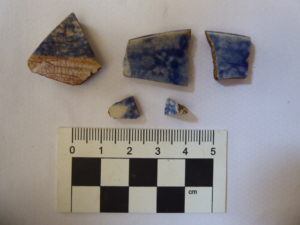As the mist lifted, Calf Hill continued to cling on to its secrets for the last day of the current dig.
The dark soil was removed from the south of the trench. It seemed to run underneath Context 2, on top of the cobbled surface.The stone features were cleaned, photographed and lifted. The feature in the north of the trench seems to be a field drain.

Stone features. Day 3. August
The trench was then mattocked and trowelled. This revealed that a surface compacted with clay was lying on top of a mixed layer of rubble and soil. This was in turn lying on top of the cobbled surface.

Cobbled surface. Day 3. August
Trench 6 revealed that the cobbled surface interpreted as a road does continue in this area. However, it has been disturbed by a possible field drain and other disturbances. Loose cobbles were found in the layer above the cobbled surface. It was not possible to find the width of the cobbled surface as the southern part of the trench was covered by the stone surface and the northern part of the trench did not reach far enough. It is at least 4 metres wide (the trench was 2mx4m). The finds above the cobbled layer suggest that it is at least pre Victorian in date, probably much earlier.
All images attributed to Catherine Rousseau Jones

Blue glaze pottery. Day 3 August 2019